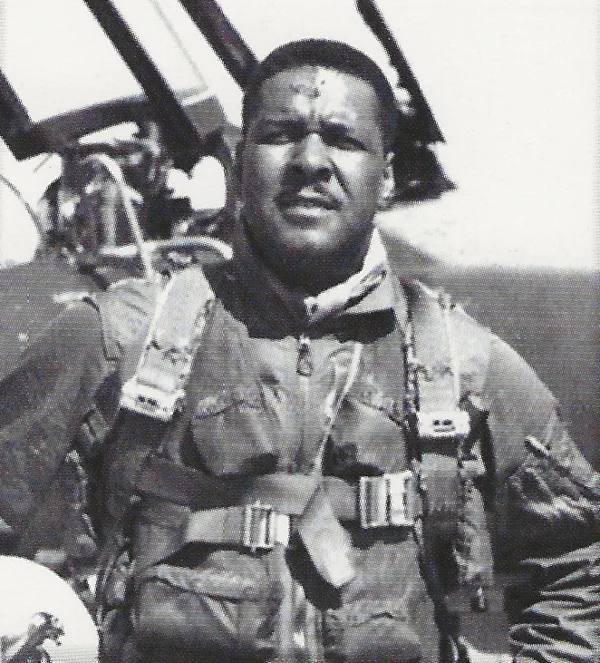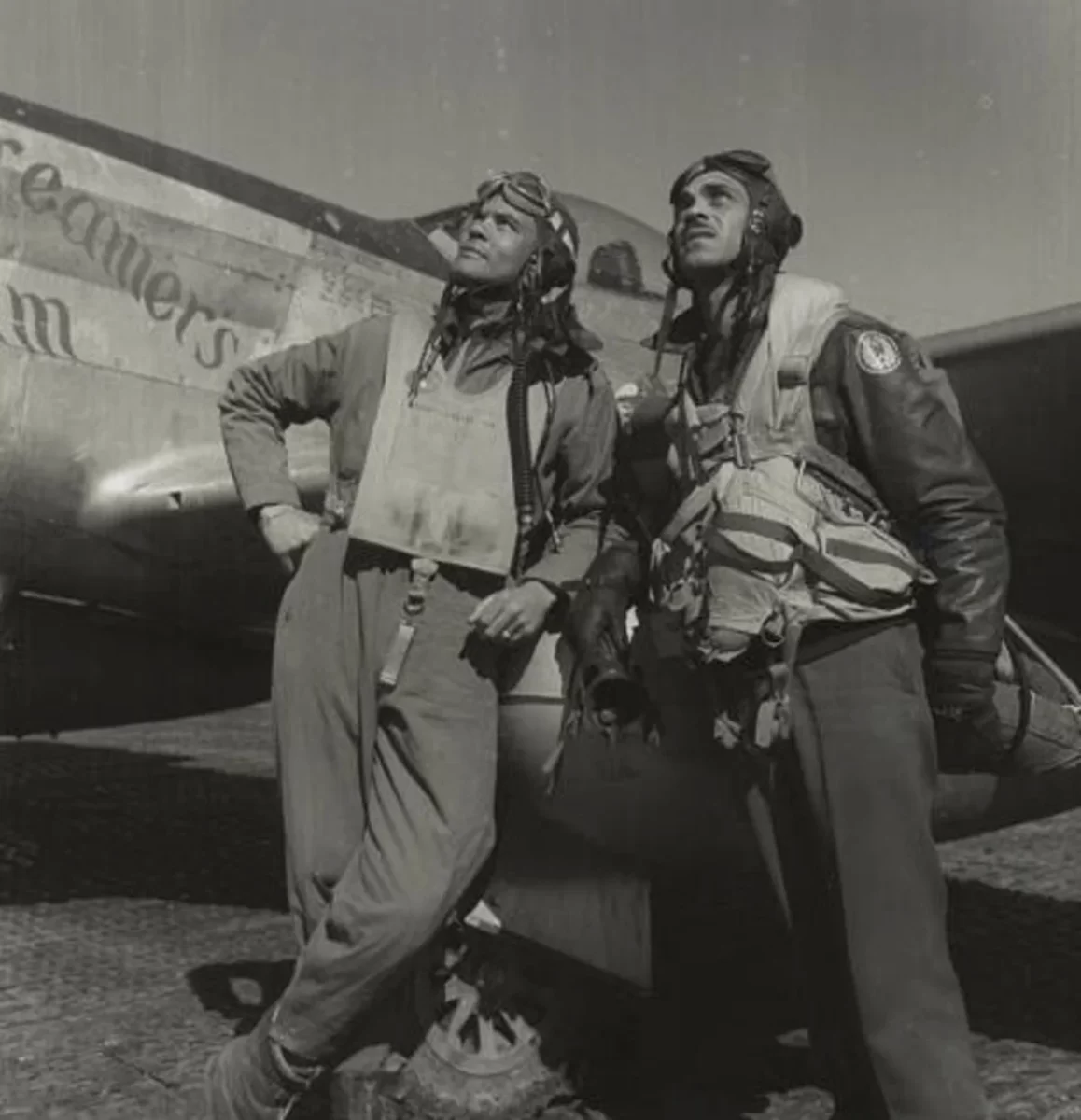![]()
By Tracy Gupton
When author Ben Vinson III was making routine visits to Brooks Manor Apartments in 1999, it is a good bet most West Columbians had no idea a celebrity was living among them. But the man Vinson, an associate professor of Latin American History at Penn State University at the time, was going to see checked many boxes to achieve celebrity status.
He was one of the famous Tuskegee airmen of World War II, a former New York stage actor, a radio host, and a man who had appeared in numerous television episodes in his younger years.
That man was Virgil Richardson. Born in Center Point, Arkansas, December 14, 1916, but raised in Texarkana where his family moved in 1918, Virgil passed away at 88 on May 15, 2004, the same year his biography was published by Palgrave/Macmillan, a New York City publishing house.
The Columbia Historical Museum in West Columbia has a copy of Vinson’s book, “Flight: The Story of Virgil Richardson, a Tuskegee Airman in Mexico,” on display in association with other artifacts and uniforms from the World War II era. In 2023 the local museum invited the public to attend a private showing of the movie “Red Tails,” starring Academy Award winner Cuba Gooding Jr., which was about the Tuskegee airmen and the battles they faced both in the air against German fighter pilots and on the ground against racism and efforts to prevent the Black pilots from seeing meaningful action alongside white U.S. Army Air Corps pilots.

A photo of Virgil Richardson at the West Columbia museum is accompanied with an informative piece revealing, “Second Lt. Virgil J. Richardson, 28, P-51 Mustang Fighter Pilot, son of Mr. and Mrs. Ross Richardson of Texarkana, has been awarded the Air Medal for Meritorious Achievement in aerial flight while participating in Sustained Operational Activities against the enemy. Lt. Richardson has completed thirteen missions. Lt. Richardson is a graduate of Dunbar High School in Texarkana and of Wiley College, Marshall, Texas. He is married to Mrs. Aida M. Richardson who resides in New York City.”
An accompanying news release dated August 29, 1944, states that, “Second Lt. Virigl J. Richardson is a member of the first all Negro Fighter group in the Army Air Forces. The group is a part of the 15th Air Force operating in Italy and acting as an escort for heavy bombers to and from their targets. It is commanded by West Pointer Colonel B.O. Davis, Jr.”
The news release on display at the Columbia Historical Museum goes on to say, “In March 1942 the first group of black fighter pilots completed their training and received their wings as Army Fighter Pilots. In August 1942, Colonel B.O. Davis Jr., the first black graduate from West Point in nearly 75 years, took command of the 99th Pursuit Squadron. That August another fighter squadron, the 332nd Fighter Group, was activated joining the 99th. In April 1943 the 99th arrived in North Africa. In July the squadron saw the first action in North Africa and downed several German planes. The 332nd Pursuit Squadron arrived in the European Theater of Operations in January 1944, and escorted bombers into Germany.”

Virgil Richardson, brother of former Charlie Brown High School head football coach Morris E. Richardson, joined the Army in March 1941. By October of 1942 he was at Tuskegee, Alabama.
“Learning to fly at Tuskegee was a marvelous and unique opportunity,” Virgil was quoted in Ben Vinson III’s biography. “Most whites in America didn’t believe that blacks had the reflexes or intelligence to fly planes. This included the president himself. They were all wrong.”
The late Morris Richardson, a retired Sweeny High School coach who, along with his wife Lois, a retired Columbia High School homemaking teacher, had been involved in the early stages of the formation of the Columbia Historical Museum, said, “In the beginning, the 99th and the 332nd Squadrons flew in the slow and outdated P-47 Fighters. Then later they became equipped with the faster and better P-51 and P-38 Fighters. The groups had shown extreme skills and were awarded those Fighters; they were the best the Air Force had at that time.”
In Vinson’s book, Virgil Richardson explained that he trained at Tuskegee flying P-40s at altitudes ranging from 15,000 to 20,000 feet. He said that he and other Black pilots at Tuskegee were sent to Florida for gunnery practice.
One of his flight instructors at the Tuskegee Institute was Daniel “Chappie” James who went on to “become a full-fledged fighter pilot and was promoted to four-star general in the mid-1970s, the first black to be awarded such rank.”

“Throughout the Corps, we became known as Red Tails, and soon, we endeared ourselves to American bomber pilots,” Virgil told his interviewer in West Columbia a quarter century ago. “While there were many white officers and subordinates who continued to detest us, and would not bother to salute us throughout our years of service, I’ll have to say that a number of white bombardiers were actually very glad to meet somebody who was a Red Tail.”
Among his favorite World War II memories, Richardson recalled a time in early 1945 when responsibilities of the Black pilots included strafing German radar installations along the coast of France. “It was an awesome sight, seeing bombers in every direction for a 150-mile stretch. Looking down into the sea we saw still more activity, throngs and throngs of ships. During these months (December 1944 through March 1945) our planes bombarded German factories and troop positions that were preparing to repel the Allied invasion.”
Virgil Richardson flew some 63 aerial missions as a U.S. Army Air Corps fighter pilot in World War II. His son, Charles Richardson, was born while Virgil was stationed in Salerno, Italy. In May 1945 “it all came to an end” and Virgil returned home to America. First, he became a Tuskegee flight instructor until he fulfilled his enlistment requirement, then moved back to New York City where he had been living and pursuing an acting career before Uncle Sam called him into military service.

This 1945 photo shows Tuskegee Airmen Benjamin Davis Jr., left, and Edward Gleed at an air base in Italy
While routinely visiting Virgil Richardson at his West Columbia apartment in 1999, Vinson wrote in Virgil’s biography that the former Tuskegee Airman “provided snippets of life in New York as a struggling actor and took pains to discuss his initial arrival in Acapulco and Mexico City during the summer of 1950. Virgil was a cofounder of the American Negro Theater in Harlem, a radio personality on WNEW (New York), and had flown 63 combat missions as a Tuskegee Airman during World War II. Virgil had also been stationed in England as a member of the U.S. Army battalion located in the port of Bristol. After the war, upon experiencing a score of racial incidents and enduring the trials of a failing marriage, Virgil fled to Mexico, eventually vowing to live there permanently.
“He continued acting, finding roles in the low-budget Tarzan and Sheena movies filmed in Mexico City during the 1950s and 1960s. He starred in Su Excelencia (1966), taking a Spanish-speaking role opposite the great Mexican film star Cantinflas. He combined his acting career with other work, including positions as a teacher, writer and professional film dubber,” Vinson writes in Richardson’s biography. “In the 1970s, he also developed an instructional aide to help language students master the fundamentals of Spanish and English grammar.”
He had recurring roles as African tribal leaders in the old “Tarzan” TV show of the 1960s that starred Ron Ely as the white jungle man. Virgil Richardson worked alongside superstars James Earl Jones and Diana Ross while filming some of those “Tarzan” episodes. In the Cantinflas film, Virgil portrayed an African diplomat who was supposed to be the ambassador of the fictional Zambombia. Virgil claims to have filmed 20 episodes of the “Tarzan” TV show in 1968.
“The studio used one of my clips to design the (1966 film Su Excelencia) promotional posters,” Richardson told his interviewer in West Columbia in 1999. “Soon, my face was plastered all over the streets of Mexico.”
Virgil returned to the United States in 1997 after a lengthy self-imposed exile from America, Vinson writes. He never returned to Mexico. “Part of Mexico’s charm was that I never had to think about color there as I had in America,” Virgil told the interviewer who was writing his biography.
Virgil Richardson spent his final days living in West Columbia near his brother Morris and sister-in-law Lois Richardson. His accomplishment in life were many and, in celebration of Black History Month, the Columbia Historical Museum honors the memory of Virgil and encourages everyone to visit the museum at 247 East Brazos Avenue in downtown West Columbia to take a tour of our museum and Rosenwald Schoolhouse. Our hours are 10 a.m. to 2 p.m. Thursdays, Fridays and Saturdays.
